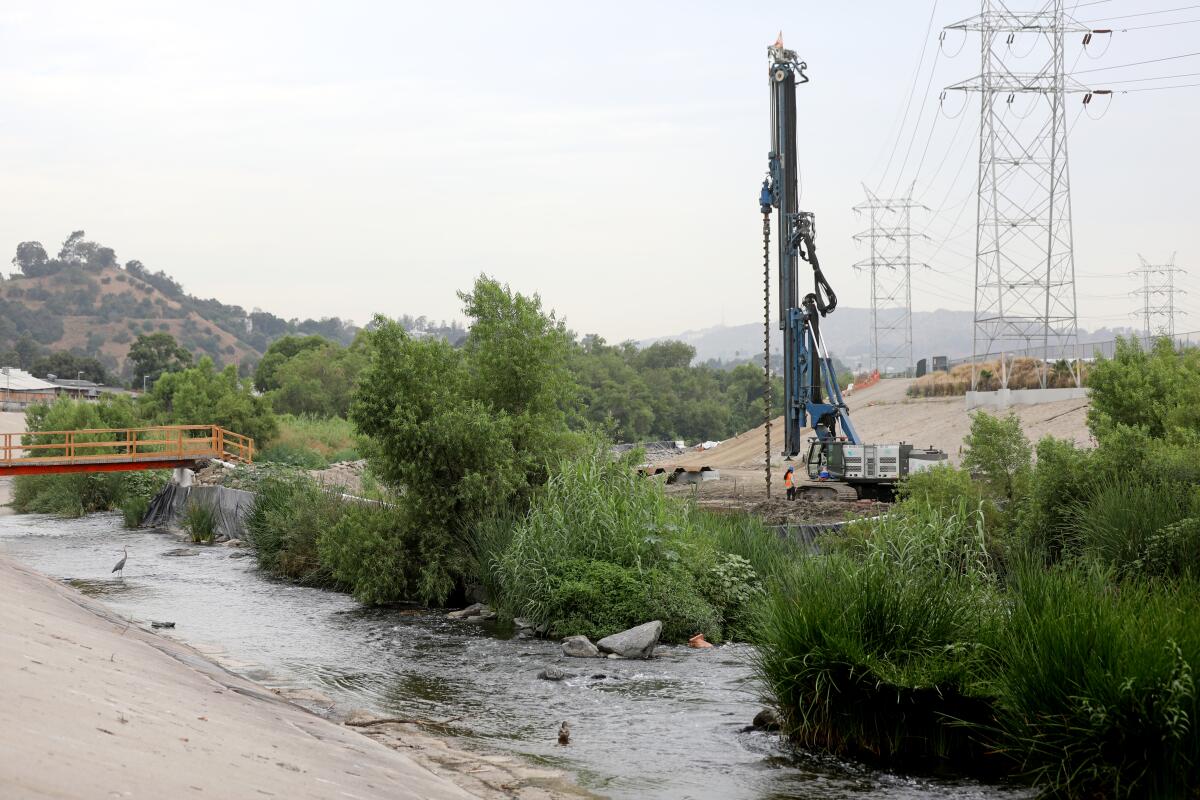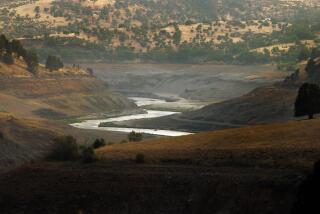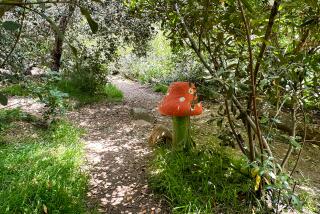This activist bought 4.5 acres of the L.A. River just to have a stake in its revitalization

An official with the U.S. Army Corps of Engineers once told Steven Appleton that there were no more frogs in Frogtown.
It was the kind of offhanded comment that made Appleton — as close as there is to a steward of Frogtown’s amphibians — wish for a cudgel to wake up feckless bureaucrats. Now, the Elysian Valley artist has obtained that cudgel.
With $15,000 from an anonymous donor, Appleton, who leads wading expeditions for frog-listening and kayaks for river tours, has purchased a piece of the Los Angeles River.
It’s about 4.5 acres that straddles the curve through Frogtown where the bottom of the concrete channel has broken up and nature has burst forth, allowing polliwogs to swim. It’s part of a $1.4 billion project by the Army Corps and city of Los Angeles to develop a 100-acre, river-themed park on the former rail switching yard north of the river.
Appleton hopes his status as owner will amplify his voice — and possibly his ability to obstruct — when officials launch infrastructure projects that disregard his vision for the river.
His current gripe is a pedestrian bridge being built just above the parcel he owns. He was on board until a last-minute design change called for a pier in the center of the channel. A section of the river has been blocked off with a dam and graded during construction.
“The whole point of this restoration is the river,” Appleton said. “The river itself right now is the least attended aspect of it.”

One of the three designs unveiled earlier this year for the Taylor Yard River Park would form a large island, described as a wildlife refuge, near Appleton’s parcel. It’s a place, he says, where Artesian springs are part of the historical fabric.
The river advocacy group Friends of the Los Angeles River has declared the Island Plan one of two worth considering. Appleton thinks so, too, but sees potential harm if the designers are not attuned to the area’s natural hydrology.
“That’s where we find the most prolific frog breeding area in Frogtown because of the uplifting that makes little ponds in the islands,” he said. “Are people’s feet wet enough to know that?”
Appleton is renowned for getting his feet wet. For more than a decade, he has been launching kayak expeditions just upstream from his newly acquired parcel. He has literally blazed water trails by moving broken chunks of concrete to eliminate obstacles to wading and kayaking.
“What I would say about Steve is he is spending a significant number of hours not on the river, [but] in the river,” said Michael Atkins, communications director for Friends of the Los Angeles River. “The last time I saw him, I was on the banks at sunset. He started leading a kayak group around.”
Atkins said he was surprised that any land in the river could be held privately, but had no qualms about Appleton being an owner.
“Both his business and his heart are in it for ecological restoration,” Atkins said.
The unlikely series of events that brought the parcel into Appleton’s hands began with a 2017 Times article that detailed several hundred properties in the river channel that were owned by individuals and companies. For reasons unknown, those properties were bypassed — and mostly forgotten by their owners — when the Los Angeles County Flood Control District acquired title to most of the river.
Already the owner of a small slice of river channel that he uses to launch kayaks, Appleton said at the time that he set a high standard for those who own river land.
“Instead of being a question of land value, it becomes a question of design and a benefit of the landowner and the public space,” he said.
He immediately recognized the value of one parcel owned by William Meade, a Bakersfield man who told The Times that he inherited it from his father who bought it at a tax sale.
“It’s a nice talking piece, but there was no value to it,” Meade said. “We tried to sell it for $4,000. I desperately tried. I got Realtors involved. Nobody wanted it.”
Meade had stopped paying taxes on it and assumed the land had been sold at auction. It had been, in fact, put up for auction, but no one had made a bid, a spokesman for the Los Angeles County assessor said. The property remained in Meade’s name with a zero tax bill.
Prompted by the article in The Times, Appleton contacted Meade, a former Highland Park resident, through a mutual friend. Meade was a willing seller, but it took until this year to close the deal.
“It seemed he’d be a better caretaker for it than I would,” Meade said after the sale was concluded this year. “He’s got the kayak thing. He’s very invested in the L.A. River. He’s literally in the river all the time.”

Appleton’s rights of ownership are not absolute. He can’t keep anyone from wading, boating or fishing in his section of the river. As a designated navigable waterway, it is open to all as a public trust doctrine right.
But ownership does give him power that he’s planning to assert. His first priority is getting the Army Corps to stop using glyphosate, the active ingredient in Roundup.
The Corps uses the herbicide, which has been accused of causing cancer, in its campaign to eradicate invasive arundo grass. Untreated, the tall clumps might back up stormwater runoff and push floodwaters over the concrete channel.
On a recent visit to his land, Appleton scowled at two orange-vested workers hacking at the vegetation with power tools.
River advocates want the arundo controlled, too, but contend there are better ways of doing it. Appleton said it should be done by hand early in the season when it’s easy to pull by the roots.
Appleton plans on leading volunteers onto his land to do just that. That’s what owning a piece of the river is really about, he said.
“It’s like kids and families going out there in an organized way with docents and guides.” He bought it, he said, “to serve the idea of the public owning a piece of the river.”
More to Read
Sign up for Essential California
The most important California stories and recommendations in your inbox every morning.
You may occasionally receive promotional content from the Los Angeles Times.











